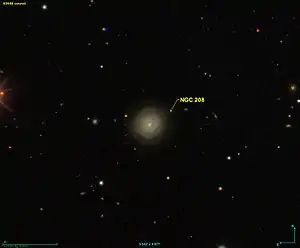NGC 208
NGC 208 is a spiral galaxy located approximately 229 million light-years from the Solar System[2] in the constellation Pisces. It was discovered on October 5, 1863 by Albert Marth.[3]
| NGC 208 | |
|---|---|
 | |
| Observation data (J2000 epoch) | |
| Constellation | Pisces |
| Right ascension | 00h 40m 17.6s[1] |
| Declination | +02° 45′ 23″[1] |
| Redshift | 0.017072[1] |
| Distance | 229 Mly[2] |
| Apparent magnitude (V) | 15.17[1] |
| Characteristics | |
| Type | Sa[1] |
| Apparent size (V) | 0.7' × 0.7'[1] |
| Other designations | |
| CGCG 383-064, MCG +00-02-118, 2MASX J00401757+0245235, PGC 2420.[1] | |
References
- "NASA/IPAC Extragalactic Database". Results for NGC 0208. Retrieved 2016-09-02.
- An object's distance from Earth can be determined using Hubble's law: v=Ho is Hubble's constant (70±5 (km/s)/Mpc). The relative uncertainty Δd/d divided by the distance is equal to the sum of the relative uncertainties of the velocity and v=Ho
- "New General Catalog Objects: NGC 200 - 249". Cseligman. Retrieved September 13, 2016.
External links
 Media related to NGC 208 at Wikimedia Commons
Media related to NGC 208 at Wikimedia Commons- NGC 208 on WikiSky: DSS2, SDSS, GALEX, IRAS, Hydrogen α, X-Ray, Astrophoto, Sky Map, Articles and images
- SEDS
This article is issued from Wikipedia. The text is licensed under Creative Commons - Attribution - Sharealike. Additional terms may apply for the media files.